When you roll your cart up to the meat cooler at the grocery store, chances are you've seen a wide variety of beef. Aside from the different cuts, there are many labels explaining how the beef was produced. Even ground beef has a plethora of options to choose from: grass fed, organic, naturally-raised, and the list goes on. But what do these labels mean? Aren't all cows fed grass in the pasture? Yes, they are, but it's the feeding during the middle and end stages of their production that makes the difference.
Beef Production Stages
Cow-Calf
It takes two to three years for beef to go from farm to fork. There are three mains stages of a cow's life. Stage one is the cow-calf segment. This is the period when the calf is born and goes from drinking milk to slowly developing their stomachs for foraging. At 6 to 10 months of age the calf is weaned (separated from its mother), at which point it weighs from 400 to 600 pounds.
Stocker or Backgrounding
Stage two is the backgrounding or stocker phase of production. This is when body weight is added to recently weaned calves. During this phase the cow spends a lot of time eating forage. Some producers use mostly pasture, letting cattle harvest the grass directly. Others who produce grain-fed beef, use feeds they have harvested and combined with grains to make the cow gain weight faster. They are sold at the end of this phase weighing 700 to 900 pounds at an age of 10 to 14 months. Because these cattle are around one year old they are called yearlings.
The final stage is finishing. This is when the cow gains its final weight before slaughter. This is where the difference in grass-finished beef and grain-finished beef comes in.
Grain Finished Beef
Grain-fed beef in feedlot
For grain-finished beef, these cattle are usually in the feedlot for 100 to 150 days. When beef is grain-finished, cattle are free to eat a balanced diet of grain, local feed ingredients, like potato hulls or sugar beets, and hay or forage at the feedyard. Many cows gain over four pounds per day in the feedlot. They are ready for sale weighing from 1,200 to 1,400 pounds. At this weight, the cattle are from 15 to 22 months old.
Grass Finished Beef
While most cattle spend the majority of their lives in pastures eating grass before moving to a feedlot for grain-finishing, grass-finished beef cattle remain on a pasture and forage diet. These cows have a forage diet throughout their whole life, with the exception of their mother's milk in the calf-cow stage. These cattle are ready for sale weighing from 1,000 to 1,200 pounds. At this weight, the cattle are from 20 to 26 months old.
Found in Beef Facts: Sustainability.
Nutrition & Taste of Grass-Fed Beef
All beef is nutrient-rich, with eight times more vitamin B12, six times more zinc, and three times more iron than skinless chicken breast, according to the Beef Checkoff. For the nutritional difference in grass-fed beef, there are a few points that stand out.
-
One 3.5-ounce serving of grass-finished beef offers 15 milligrams more omega-3 than other kinds of beef. However, in general, beef is not considered a primary source of omega-3 fatty acids.
-
While grass-finished beef can contain more conjugated linoleic acid (CLA) than other kinds of beef, research has not determined whether this difference results in a more significant health benefit. Health professionals believe CLA, a polyunsaturated fatty acid, has cancer fighting properties.
-
Grass-finished beef provides 4% of the Daily Value for Vitamin E compared to 1.5% for grain-fed beef. Vitamin E-rich foods, like almonds, provide 24% of the Daily Value for Vitamin E.
As for taste, most consumers say grass-finished beef has a different taste than grain-finished beef. The foods the cattle eat have a major impact on the way they eventually taste. When cattle are given corn feed, it leads to higher-levels of marbling and gives the beef a slightly sweeter taste. When cattle are fed only forage, they produce less marbling. Grass-fed steaks also have a much more mineral-heavy taste that's often described as “meatier” or “gamier." Obviously, a marinade during meal preparation can make a difference on the taste.
A Strong & Growing Market
Though the gap has narrowed recently, organic grass-fed beef still sells at a premium to its grain finished counterpart.







